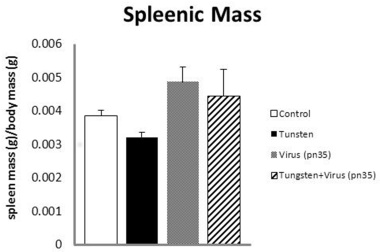


Posted March 12, 2013
Dr Robert C. Lantz, University of Arizona
 In a Fiscal Year (FY) 2009 Concept award begun by Dr Mark Whitten and, after his retirement, continued by Dr Robert C. Lantz (with Ms Cindy Fastje and Dr Paul Sheppard) of the University of Arizona studied the carcinogenic potential of JP-8 (a type of jet fuel) and tungsten (a heavy metal) in a murine model. Both JP-8 and tungsten are toxicants that military members and their families might be exposed to when living near air fields, bases, and installations. To delve into the possible risks, Dr Lantz and his collaborators worked to tease out the multiple factors which might lead to increased cancer risk. In previous studies, the researchers had been able to show that in utero exposure to tungsten followed by postnatal exposure to a specific lung virus (respiratory syncytial virus- RSV) led to the development of diseases in mice that were similar to human leukemia. The FY09 Peer Reviewed Cancer Research Program Concept award evaluated the effects of in utero exposures to tungsten or to JP-8 and exposure to different viruses. After exposures, analysis was performed at several different ages to determine the levels of white blood cells and weight of the spleen, an organ that is responsible for producing the white blood cells. For animals that were exposed to a virus and the toxicants during in utero development (first hypothesis), Dr Lantz and his collaborators did not find any significant differences between unexposed animals and the treated animals.
In a Fiscal Year (FY) 2009 Concept award begun by Dr Mark Whitten and, after his retirement, continued by Dr Robert C. Lantz (with Ms Cindy Fastje and Dr Paul Sheppard) of the University of Arizona studied the carcinogenic potential of JP-8 (a type of jet fuel) and tungsten (a heavy metal) in a murine model. Both JP-8 and tungsten are toxicants that military members and their families might be exposed to when living near air fields, bases, and installations. To delve into the possible risks, Dr Lantz and his collaborators worked to tease out the multiple factors which might lead to increased cancer risk. In previous studies, the researchers had been able to show that in utero exposure to tungsten followed by postnatal exposure to a specific lung virus (respiratory syncytial virus- RSV) led to the development of diseases in mice that were similar to human leukemia. The FY09 Peer Reviewed Cancer Research Program Concept award evaluated the effects of in utero exposures to tungsten or to JP-8 and exposure to different viruses. After exposures, analysis was performed at several different ages to determine the levels of white blood cells and weight of the spleen, an organ that is responsible for producing the white blood cells. For animals that were exposed to a virus and the toxicants during in utero development (first hypothesis), Dr Lantz and his collaborators did not find any significant differences between unexposed animals and the treated animals.
For the second hypothesis, in utero exposure to tungsten followed by postnatal infection with RSV. The results were different and showed leukemia-like alterations in mice. This data has been published in Fastje, C.D., Harper, K., Sheppard, P.R., Witten, M.L. In Utero Exposure to Sodium Tungstate and Post-Natal Exposure to Respiratory Syncytial Virus Results in Hematological/Immunological Disease in Mice: Implications for Childhood Leukemia. Chemico-Biological Interactions. 2012;196(3):89-95. These result support a multi-step carcinogenic pathway illustrating that toxicant exposure in utero followed by postnatal infection with virus and not in concert during in utero development is critical to understanding the cancer risks. However, these alterations were not seen when animals were exposed to either tungsten or jet fuel in utero followed by postnatal exposure to the Epstein-Barr virus (Fig 1).
These results indicate that the responses are specific for the type of viral infections after birth and the sequence of exposure. This indicates that there may be differences in the responses based on the types of virus and/or the cell types that they infect. The overall response therefore, may be specific for particular viral interactions and is not just a general effect of the JP-8 jet fuel or tungsten on inflammatory responses. The results demonstrate that environmental exposures during fetal development and long term exposures after birth play a significant role in health outcomes, particularly in the risk of cancer development.
Dr Lantz and his research group plan to identify possibly cellular and/or molecular targets of the toxicants and viral particles. By accomplishing this, they hope to find ways to intervene to reduce or eliminate the effect of toxicants on cancer risk as well as finding early ways to detect alterations that might lead to cancer development.

Fig 1. Spleenic mass following in utero exposure to tungsten and postnatal exposure Epstein-Barr Virus. Data are from 35 day old animals. No significant differences were seen.














